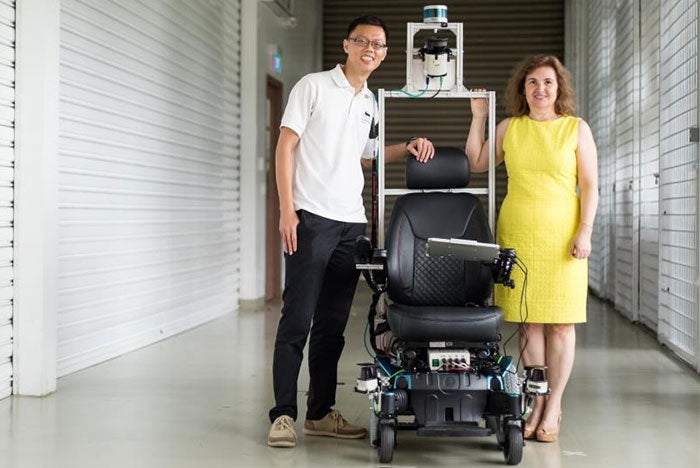Tech talk: A self-driving wheelchair, artificial intelligence and RFID
Hospital gets smart with self-driving wheelchair

SMART self-driving wheelchair flanked by (left) Dr Eng You Hong and Prof Daniela Rus
The Singapore-MIT Alliance for Research and Technology (SMART) is making headway in self-driving technology with its autonomous wheelchair that is currently being piloted at Singapore’s Changi General Hospital.
The group of researchers form the Massachusetts Institute of Technology and the National University of Singapore have combined autonomous vehicle technology and mobility-on-demand concepts to create a self-driving wheelchair that they say can reduce traveling times in hospitals and free up time for health care providers.
The wheelchairs can be programmed with a map of the facility’s layout and are able to detect stationary and moving obstacles.
Watch the video below to learn more:
Researchers use AI to track hand-washing compliance
Researchers based at Stanford (Calif.) University and the Swiss Federal Institute of Technology in Lausanne have developed an AI camera-tracking system to monitor hand washing among clinical staff.
Sensors were installed in top-down views above hand-sanitizer gel dispensers, in side views overlooking the corridors, inside patient rooms, and in the corners of rooms overlooking sinks and patient beds to automatically identify when staffers and patients use hand sanitizers.
The system then maps out their movement via depth-based images captured by the camera system. The researchers tested the system and found it to be 75 percent accurate, compared with 63 percent accuracy in a study that used a single undercover observer to track compliance.
RFID automates asset management of clinical equipment
St. Luke’s International Hospital in Tokyo is using radio-frequency identification (RFID) to track equipment throughout its 646,000-square-foot facility. The hospital has centralized equipment such as infusion pumps, syringe pumps, suction devices and more in clinical engineering rooms. Before installing the RFID system, nurses would scan an asset to show when it had been borrowed or returned. To save time, however, many nurses simply would keep the asset at their workstation, which made it hard to manage assets.
Under the new automated system, sheets with smart sensors are placed on shelves in the centralized rooms. The items placed on the shelves are tagged with data about the item that are stored in a software system. When staff members remove an item from the engineering room, the software automatically updates and updates again as “in use” if the equipment is not returned within 120 minutes. Once staffers are finished with the asset, they can return it to any of the centralized rooms and the software will update with the new location.




